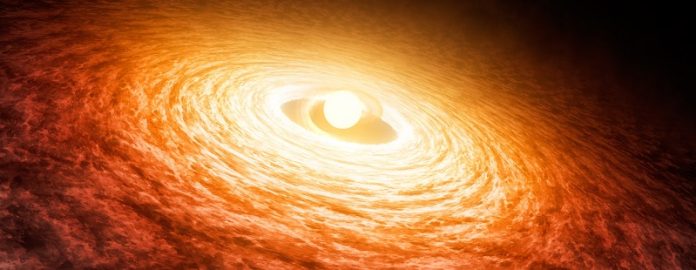
Astronomers using NASA’s Hubble Space Telescope have uncovered surprising details about the young star FU Orionis (FU Ori) in the constellation Orion.
Nearly 90 years ago, FU Ori astonished scientists by becoming 100 times brighter in just a few months, a rare event that has kept researchers intrigued ever since.
Now, new ultraviolet observations reveal that the disk of material surrounding FU Ori is much hotter than expected, reaching an incredible 16,000 Kelvin—nearly three times the surface temperature of the Sun.
This finding challenges previous theories about how young stars grow and interact with their surrounding disks.
Young stars like FU Ori pull in gas and dust from nearby disks, a process known as accretion. While most young stars, called T Tauri stars, keep their disks at a safe distance due to magnetic fields, FU Ori is different.
Its disk becomes unstable and touches the star’s surface, creating a “hot shock” that emits intense ultraviolet light.
Using Hubble’s advanced ultraviolet instruments, astronomers led by Adolfo Carvalho and Lynne Hillenbrand from Caltech studied this shock zone for the first time. “We were surprised to find that the temperature was much higher than predicted—double what previous models estimated,” Carvalho explained.
This extreme heat occurs where the rapidly spinning disk material slams into the slower-moving surface of the star. The impact causes the material to heat up significantly, making FU Ori far brighter than typical young stars.
FU Ori’s intense outbursts affect the surrounding environment, including any planets forming in its disk.
If planets form far from the star, they may inherit unique chemicals influenced by these outbursts. However, planets forming too close to FU Ori face a harsher fate. “Planets near the star could be dragged inward and destroyed within just a few outbursts,” Carvalho noted.
This discovery highlights how the extreme conditions around FU Ori can shape the future of its planetary system, providing insights into how stars and planets evolve.
The research team is continuing to study FU Ori, analyzing spectral data from Hubble to learn more about the gas movements and chemical makeup of its disk. These findings will help astronomers better understand the dramatic life of young stars like FU Ori and their role in the universe.
As Hillenbrand explained, “Hubble’s capabilities allow us to peer deeper into the inner workings of FU Ori than ever before, unlocking secrets of this fascinating star.”
The results of this study were published in The Astrophysical Journal Letters and mark an exciting step forward in understanding young stars and their fiery beginnings.



